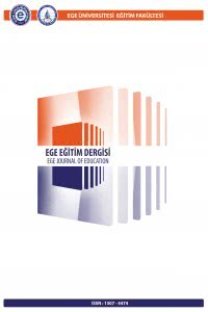Öğretmen Devamszılığının İncelenmesi: Menderes İlçesi Örneği
Bu araştırmanın amacı, öğretmenlerin çeşitli bireysel ve mesleki özelliklerinin öğretmen devamsızlığına etkisini araştırarak durum saptaması yapmak ve Milli Eğitim Bakanlığı, il ve ilçe milli eğitim müdürlükleri ile okul yöneticileri için öneriler getirmektir. Araştırma, İzmir ili Menderes ilçesinde 2011-2012 Eğitim Öğretim yılında görev yapan 564 öğretmenin katılımı ile gerçekleştirilmiştir. Katılımcılara ilişkin veriler Öğretmen Devamsızlığı Veri Toplama Formu ile toplanmıştır. Araştırma kapsamına alınan okullarda görev yapan öğretmenler, bir eğitim öğretim döneminde X = 4,20 günlük bir devamsızlık ortalamasına sahiptirler. Öğretmenlerin %25,4’ü yıl boyunca sevk, rapor veya izin kullanmamışlardır. Yapılan araştırmada, Menderes ilçesindeki ilköğretim veortaöğretim kurumlarında görev yapan öğretmenlerin devamsızlık oranlarının, öğretmenlerin mezun oldukları fakültelere, medeni durumlarına, sahip oldukları çocuk sayısına, ikamet ettikleri ilçeye, branşlarına, kıdemlerine ve görev yaptıkları okuldaki çalışma sürelerine göre anlamlı farklılık göstermediği bulunmuştur. Öte yandan öğretmenlerin devamsızlık oranlarının okulun bulunduğu yerleşim yeri, okulun türü, okulun öğretim şekli, öğretmenlerin cinsiyetleri ve öğretmenlerin yaşlarına göre anlamlı farklılık gösterdiği bulunmuştur. Öğretmenlerin devamsızlık oranları ile öğrencilerin seviye belirleme sınavı puanları arasında anlamlı bir ilişki bulunamamıştır.
Anahtar Kelimeler:
Devamsızlık, öğretmen devamsızlığı, öğrenci başarısı.
-
The aim of this study is to investigate different professional and demographic variables of teachers effects onteachers’ absenteeism and make recommendations to Ministry of Education, to district and provincial education directorates and to school managers. The study was conducted with participation of 564 teachers who were working in primary and secondary schools of Izmir, Menderes District in 2011-2012 academic year. Data were collected by using ‘Teacher Absenteeism Data Collection Form’. The average absenteeism rate of the teachers who work in the schools where this research was conducted is X =4,20 days in an academic year. The 25,4% of the teachers did not use any medical referral, medical report and leave of absence during a school year. The research shows that there is no difference on absenteeism rates of the teachers who work in the Menderes District’s primary and secondary schools based on their marital status, number of children they have, their district of residence, their branch, seniority, or whether they are graduated from faculty of education or not and how long they have been working in their schools. Research shows that all these variables have no effects on the absenteeism rates of the teachers. On the other hand, the variables such as the location and type of the school they work, whether the school has a full-day or half-day programme, the gender and age of the teachers affect teachers’ absenteeism rates. There is no correlation between teachers’ current absenteeism rate and students’ Placement Level Test scores.
Keywords:
Absenteeism, teacher absenteeism, student achievement.,
___
- Akhtar, M. (2013). A comparative study of government and private school teachers to explore the causes of absenteeism at secondary level in district bahawalnagar, Punjab, Pakistan. Journal of Education and Vocational Research, 4 (8), 225-229.
- Bacak, B. ve Yiğit, Y. (2010). İşe devamsızlığın nedenleri, ekonomik sonuçları ve azaltılması için alınması gereken önlemler, Girişimcilik ve Kalkınma Dergisi, 5(1), 29–44.
- Brown, S.L. ve Arnell, A.T. (2012). Measuring the effect teacher absenteeism has on student achievement at a “urban but not too urban: Title 1 elementary school, International Journal of Humanities and Social Science, 2(17), 172-183.
- Cemaloğlu, N. ve Şahin E.D. (2007). Öğretmenlerin mesleki tükenmişlik düzeylerinin farklı değişkenlere göre incelenmesi. Kastamonu Eğitim Dergisi, 15 (2), 465-484.
- Chapman, D. (1994) . Reducing teacher absenteeism and attrition: Causes, consequences and responses. Paris: UNESCO.
- Devamsızlık yapan öğretmeni takip edin. (2012, 1 Ağustos). Akşam Gazetesi [Ulusal Baskı]. http://www.aksam.com.tr/guncel/devamsizlik-yapanogretmeni-takip-edin--130144h/haber-130144
- Duflo, E., Hanna,R., Ryan, S.P. (2011). Incentives work: Getting teachers to come to school, American Economic Review , 102 (4), 1241–1278.
- Finlayson, M. (2009). The Impact of Teacher Absenteeism on Student Performance: The Case of The Cobb County School District. (Yayımlanmamış doktora tezi). Kennesaw State University, Kennesaw.
- Goodman, P.S. and Atkin, R.S. (1984). Effects of Absenteeism on Individuals and Organizations. San Francisco: Jossey-Bass, Inc.
- Jacobs, K.D., ve Kritsonis, W.A (2007). An analysis of teacher and student absenteeism in urban schools: what the research says and recommendations for educational leaders. The Lamar University Electronic Journal of Student Research, fall 2007.
- Lewis, E.A. (2008). Can teacher absenteeism be linked to lower test scores? http://k6educators.about.com/b/2008/01/17/can-teacher-absenteeismbe-linked-to-lower-test-scores.htm
- Lockhart, J. (2001). Managing absenteeism for improved productivity and costeffectiveness, (Yayımlanmamış yüksek lisans tezi). Cape Technikon, Cape Town.
- Norton, M. S. (1998). Teacher absenteeism: A growing dilemma in education. Contemporary Education, 69 (2), 95.
- Obeng-Denteh, W., Asiamah Yeboah, E., Sam, C. ve Esi Monkah, J. (2011). The impact of student and teacher absenteeism on student performance at the junior high school: The case of the kumasi-metro school district. Continental Journal of Education Research, 4 (1), 7-17.
- Ordu, A. (2011). İlköğretim okullarında örgütsel yapı ile örgüt sağlığı arasındaki ilişkiler. (Yayımlanmamış doktora tezi). Pamukkale Üniversitesi, Denizli. Örücü, E. ve Kaplan E. (2001). Kamu ve özel sektör çalışanlarında devamsızlık sorunu. Yönetim ve Ekonomi, 7, 1.
- Raegen, M. (2012). Teacher absence as a leading indicator of student achievement. http://www.americanprogress.org/issues/education/report/2012/11/0 5/40371/teacher-absence-as-a-leading-indicator-of-studentachievement/
- Rogers, F.H., Vegas, E. (2009). No More Cutting Class? Reducing Teacher Absence and Providing Incentives for Performance, Policiy Research Working Paper (Report No:4847): WORLD BANK.
- Sezgin, F. (2010). Öğretmenlerin örgütsel bağlılığının bir yordayıcısı olarak okul kültürü, Education and Science. 35 (156), 142-159.
- Şahin, F. (2011). İşe devamsızlığın nedenleri, sonuçları ve örgütler için önemi, Niğde Üniversitesi İİBF Dergisi, 4 (1), 24-39.
- ISSN: 1307-4474
- Yayın Aralığı: Yılda 3 Sayı
- Başlangıç: 2001
- Yayıncı: Ege Üniversitesi Eğitim Fakültesi
Sayıdaki Diğer Makaleler
Miville-Guzman Evrensellik-Farklılık Yönelimi Ölçeği Kısa Formu’nun Türkçe’ye Uyarlanması
5E Öğrenme Modeli’ne Göre Düzenlenmiş Eğitim Durumlarının Bilimsel Süreç Becerilerine Etkisi
Psikolojik Danışma ve Rehberlik Alanında Analog Araştırmal
Öğretmenlerin Uzaktan Hizmet İçi Eğitim Deneyimlerinin İncelenmesi
Elif TAŞLIBEYAZ, Selçuk KARAMAN, Yüksel GÖKTAŞ
Ebru DEMİRCİOĞLU, Murat ÖZDEMİR
İbrahim UYSAL, Güler DUMAN, Elif YAZICI, Merve ŞAHİN
Boş Zaman Can Sıkıntısı Ölçeği’nin Türkçe’ye Uyarlanması
Orta Öğretimde Görev Yapan Öğretmenlerin FATİH Projesi’ne İlişkin Görüşleri
